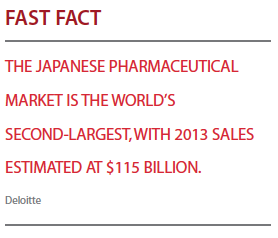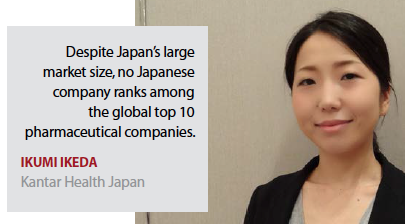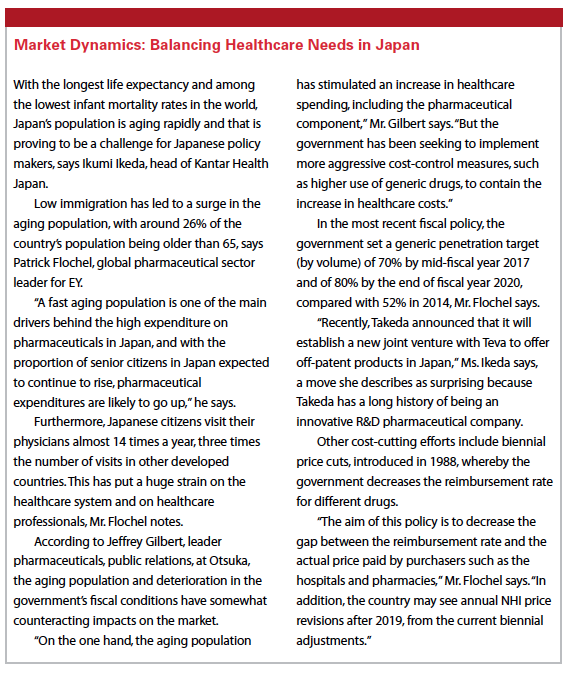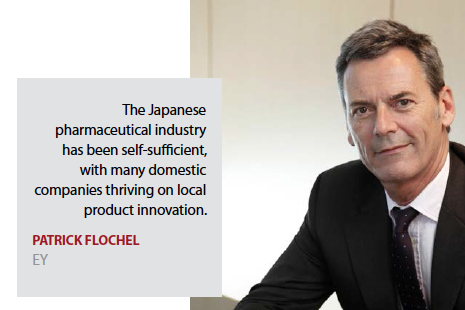 A s one of the world’s biggest economies and a well-established pharmaceutical powerhouse, Japan has for many years been a difficult market for foreign companies to enter independently. Increasingly, however, the Japanese market is opening to international companies.
A s one of the world’s biggest economies and a well-established pharmaceutical powerhouse, Japan has for many years been a difficult market for foreign companies to enter independently. Increasingly, however, the Japanese market is opening to international companies.
“In the past companies were essentially entering the market through joint ventures with local Japanese pharmaceutical companies; now foreign companies can set up their operations freely without legal hurdles or involvement with domestic pharmaceutical companies," says Patrick Flochel, global pharmaceutical sector leader for EY. “Global generic players are also trying to boost their presence in Japan to take advantage of the government’s plans to increase generic penetration in the country. Conversely, the Japanese pharmaceutical sector is slowly but surely becoming more globalized. Japanese companies are expanding their presence in other countries through M&A and R&D investments in the United States, Europe, and Asia."
The Pharma Picture
As a pharmaceutical market, Japan is second only to the United States in terms of sales, having reached $80 billion in sales in 2014, says Ikumi Ikeda, head of Kantar Health Japan.
 “Despite its large market size, no Japanese company ranks among the global top 10 pharmaceutical companies," Ms. Ikeda says. “The Japanese market is too large to be ignored and too small to lead the global pharmaceutical market. The Japanese market is based on a very Japan-grown management culture that sometimes prevents market growth in terms of innovation and globalization."
“Despite its large market size, no Japanese company ranks among the global top 10 pharmaceutical companies," Ms. Ikeda says. “The Japanese market is too large to be ignored and too small to lead the global pharmaceutical market. The Japanese market is based on a very Japan-grown management culture that sometimes prevents market growth in terms of innovation and globalization."
Ms. Ikeda adds, however, that some Japanese pharmaceutical companies have excellent pipelines.
Within the country, while U.S. and European companies make up the majority of the top 10 pharma companies by market share, many large pharma companies have scaled back their R&D in Japan. Jeffrey Gilbert, leader pharmaceuticals, public relations, at Otsuka, explains that similar to multinational companies in some other industries, the pendulum is starting to swing back toward having an in-country R&D presence in Japan as a way to capture new ideas.
Focus on Innovation
As part of the Japanese government’s focus to increase healthcare innovation, in the past several years it has excluded certain new drugs from the mandated, biennial price cuts that are applied to all other drugs, and it has beefed up the staffing of the review body to get drugs on to the market more quickly, Mr. Gilbert notes.
“The landscape is changing — defined by high-end drugs with innovative value for top prices and low-priced established drugs and generics," Ms. Ikeda says.
There is also an economic imperative to revitalizing the pharmaceutical industry.
Ms. Ikeda notes that on June 14, 2013, the government initiated the Japan Revitalization Strategy, which includes a healthcare and medical strategy with the aim of achieving international competitiveness of the Japanese healthcare and medical industries.
 Dr. Jotaro Shinagawa, VP and head of product development services at Quintiles, says the Japanese government understands that the pharmaceutical/medical industries can help fuel economic growth.
Dr. Jotaro Shinagawa, VP and head of product development services at Quintiles, says the Japanese government understands that the pharmaceutical/medical industries can help fuel economic growth.
“The government is focused on reviewing current regulatory processes to enhance efficiency and productivity in product development," Dr. Shinagawa says. “From the beginning of 2016, the government will begin using Health Technology Assessments to review new medicines."
As part of the strategy the government is working to promote the practical application of pharmaceuticals, medical devices, and regenerative medicines and create cutting-edge, innovative medical products with the potential to acquire global market share, Ms. Ikeda says.
“Historically, the Japanese industry has been heavily focused on domestic R&D, but the Japanese government wants to make the industry globally competitive and has changed the R&D process to make it more transparent and evidenced-based," Ms. Ikeda says.
Mr. Flochel says the government established the Agency for Medical Research and Development, a Japanese version of the U.S.-based National Institutes of Health and the UK’s National Institute for Health Research, to support and fund new product development in the pharma and medical devices sectors.
“The MHLW has drafted a comprehensive strategy to increase the competitiveness of the domestic pharma sector," Mr. Flochel says. “The three key pillars of the draft are intended to encourage innovation, create harmonization with international regulations, and strengthen product classification, clinical research, and distribution facilities."
From R&D to Commercialization
Japanese pharmaceutical R&D has been the source of many global blockbusters, the latest being Nivolumab with expected sales of $7 billion by 2020, Mr. Flochel says.
According to Gavin Buffett, communications specialist at Otsuka, Japan is a global leader in several fields of medicine, including induced pluripotent stem cell (iPS) and cell tissue culture.
 “Japan has a framework in place to fast track Phase II for regenerative and cell-based medicines, allowing innovative drugs to reach the market faster than anywhere else in the world," Mr. Buffett says. “Regulators are very sophisticated in their ability to assess biologics in terms of safety and efficacy because they approved some of the first ones on the market."
“Japan has a framework in place to fast track Phase II for regenerative and cell-based medicines, allowing innovative drugs to reach the market faster than anywhere else in the world," Mr. Buffett says. “Regulators are very sophisticated in their ability to assess biologics in terms of safety and efficacy because they approved some of the first ones on the market."
With increasing government funding, the industry is targeting early-stage drug discovery in neglected diseases, Mr. Flochel says.
“For example, Takeda joined WIPO Re:Search, a consortium to accelerate the R&D of new drugs, vaccines, and diagnostics for neglected tropical diseases," he says. “Similarly, the Drugs for Neglected Diseases initiative — DNDi — and a consortium of companies including Eisai, Takeda, and AstraZeneca have announced the start of an initiative to accelerate early-stage drug discovery for leishmaniasis and Chagas disease."
Genomics is another area of interest in Japan, and the cabinet has called for expediting the development of a cancer patient registry to boost the industry, Mr. Flochel notes.
“The MHLW is expected to ask for a separate budget next fiscal year to create a genomic data collection and to build a patient registry-based infrastructure to propel clinical studies on rare diseases," he says. “There also have been precompetitive collaborations/consortia to sift through the deluge of genomics, proteomics, chemistry, and biology data to improve target validation and find new therapeutic targets. For example, in 2012, Takeda joined the open-source research consortium Structural Genomics Consortium to improve basic scientific understanding of the biology of major diseases, including cancer, HIV, Alzheimer’s, and autoimmune diseases."
In terms of therapeutic focus, Ms. Ikeda says the Japanese government’s priority is oncology, rare disease, infectious disease, and dementia.
Dr. Shinagawa notes this focus is not surprising given that cancer is the No. 1 cause of death in Japan.
“Growth therapeutic areas in 2014 were antithrombogenic drugs, oncology, diabetes, and immunosuppressant drugs, while lifestyle diseases such as hypertension and hyperlipidemia are slightly decreasing," Ms. Ikeda adds.
Dr. Shinagawa says clinical development in the country is complex, and the regulatory barriers to approval are high; authorities require significant amounts of data and a focus on safety.
“The efficiency and the productivity of conducting clinical trials in Japan is affected by the complexity of clinical trial procedures, undeveloped clinical trial facilities, and limited English skills," Dr. Shinagawa says. “As a result, there is a lag between the availability of new medicines in Japan compared with the United States and Europe. Currently, the Japanese regulatory authorities are looking at how to introduce new medicines faster."
Mr. Flochel agrees that the Japanese pharmaceutical industry is impacted by the “drug lag" issue, a reference to the delay in the approval for a drug in Japan versus other foreign markets.
“In 2005, the delay in approval could be as long as 10 years for a drug, and in some cases drugs are not launched in Japan at all due to this issue," he says.
“To speed up the process, the country has introduced sakigake, or a fast-track review system, on a trial basis. The system offers a series of privileges for drugs that belong to any of four categories — novel mechanism of action, demonstrates high effectiveness, targeted at life-threatening diseases, or first approval planned for Japan, ahead of any other geography. The ministry has already designated 11 unapproved/off-label drugs for this system under the unmet needs category."
To launch a product in Japan, Ms. Ikeda says partnering with local companies is key to success. However, there can be some difficulties due to language and cultural barriers.
One of the big differences between the United States and Japan is the role of the salesforce, Mr. Buffet says.
“Pharma companies in Japan have a lot of feet on the ground," Mr. Buffett says. “The doctors still value that one-to-one communication with the rep."
Ms. Ikeda adds that Japanese physicians prefer to see sales reps from local pharmaceutical companies rather than multinational pharmaceutical companies.
Mr. Flochel adds that e-detailing is emerging as a key platform for pharma-physician interaction, but is used in combination with visits from sales representatives to build the relationship with healthcare practitioners.
Mr. Gilbert says the size of salesforces will continue to decline over the coming decade as specialty drugs start to outweigh primary care drugs.
The Healthcare Picture
 Japan has a universal healthcare system, and all citizens can access medicines and healthcare in hospitals and clinics throughout the country, Dr. Shinagawa says.
Japan has a universal healthcare system, and all citizens can access medicines and healthcare in hospitals and clinics throughout the country, Dr. Shinagawa says.
Every citizen is required to join one of the various industry-managed health insurance programs or the National Health Insurance (NHI) scheme, Mr. Flochel says.
“The government is the main source of funds for healthcare, accounting for almost 82% of all costs; the remaining 18% is covered by private insurers, provided by employers," he says.
Historically, in Japan, physicians were allowed to both write prescriptions for patients and also dispense the necessary medications, Mr. Flochel says.
“However the government is now promoting the practice of ‘Iyaku Bungyo’ to give more power to pharmacists," he says. “Iyaku Bungyo refers to the practice of separation of prescribing and dispensing of pharmaceuticals. Following these changes, the percentage of prescriptions dispensed by pharmacists rose from less than 40% of all prescriptions in 2000 to 67% in 2013, while the number of community pharmacies increased from 48,252 to 57,071."
In 2009, the Japanese government deregulated the sales of over-the-counter drugs, allowing sales in convenience stores and supermarkets, Mr. Flochel adds.
There is no system of family doctors in the healthcare system, Mr. Flochel says.
Patients can seek treatment at any clinic or hospital across the country, as long as they have their health insurance certificates.
Mr. Buffett says medical education in Japan is based on the old German system, where doctors specialize rather than having broad experience, such as required for family medicine.
“Medical education was traditionally based on the study of organs so doctors learned differently from the system in the west," he says. “However, things are changing, as more doctors train outside of Japan."
Physicians are not easily accessible, and Japan has strict physician payment guidelines, which pharma companies need to comply with, Mr. Flochel says.
“In the United States the power of physicians has been diminished over the past 20 years or so through managed care, consolidation in the health insurance and hospital sectors, etc., but that has not happened in Japan as physicians — particularly opinion leaders — retain a more powerful position, and because the government has dispersed the impact of cost and price that cuts across all the participants in the healthcare sector," Mr. Gilbert says.
Dr. Shinagawa notes that medicines that can be purchased over the counter in other countries are often still prescription only in Japan.
“A more recent change, however, is that clinicians are no longer able to prescribe branded medicines once the patent has expired, hence generic use is increasing," he says. (PV)


















